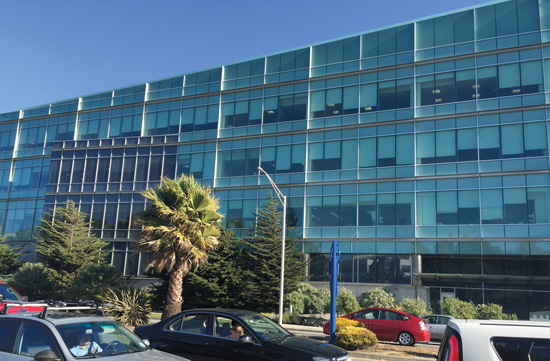The Health and Design Benefits of Accessing Daylight and Views with Dynamic Glass
Potential Dangers of Uncontrolled Daylight
Daylight can deliver significant light and heat energy through a window and into the interior of a building. Uncontrolled daylight can be, and often is, problematic, creating glare and disrupting the thermal comfort and energy efficiency of the environment with excessive heat gain. Unfortunately, the potential costs associated with glare and heat gain can quickly negate any potential benefit. The 2003 Heschong Mahone Californian Call Center study quantified the cost of glare, finding that it caused a 17 percent decrease in productivity. Other studies have quantified the impact that thermal discomfort can have on productivity. While performance peaks between 69 and 72 degrees Fahrenheit, increasing or decreasing temperature from this range reduces productivity. At 86 degrees Fahrenheit, productivity is reduced by 10 percent.
Glare
Glare compromises the productivity and well-being of people. It is distracting, causes discomfort, and impedes visibility, making it difficult to work. Glare can also affect well-being by causing eyestrain, headaches, fatigue, and irritability.
Glare is experienced for two different reasons. Either there is simply too much light available in a space or emitted from an object, such as a direct beam from the sun, or there is too much contrast in the intensity of the light that is visible within a field of view.
Direct beam sunlight always offers too much light, as much as 100,000 lux. This intensity causes discomfort if it is viewed without some type of shade, shield, or mechanism to modulate its intensity. It is just too bright, especially when compared to the recommended level for task lighting of 300-500 lux and the limit of 1000-3000 lux, above which daylight designers consider a space to be over-lit.
The discomfort caused by glare will motivate people to create some way to shield themselves, most often using blinds if they are available, and if not, taping of paper or cardboard to the windows is not unheard of. Neither provides the exterior aesthetic that designers envision, nor does it deliver the intended daylight and views performance.
Solar Heat Gain
Solar heat gain occurs when the light from the sun passes directly through the window and into the interior, heating it up, or when sunlight is absorbed at the window and a portion of the resulting heat is then radiated into the interior, which also heats it up. Too much solar heat gain or loss will negatively impact the load on the HVAC system and compromise the thermal comfort of occupants in the building.
Comparing Static and Dynamic Daylight Management Solutions
Today, a typical glazed facade incorporates static sun management components, such as high-performance static glass, fixed external horizontal sun-shades or overhangs for additional solar control, and interior blinds, predominantly manually controlled, for glare control.
The dynamic nature of daylight makes it difficult to manage effectively with these facade solutions, especially when design objectives demand that not only is glare prevented, but also that diffuse daylight admission in the interior and views are maximized. For example, it is particularly challenging to manage the sun on east and west elevations using exterior horizontal sunshades or overhangs, because of the low angle sun that the over-hang will not block. Occupants then pull the blinds to manage the glare, blocking the view and daylight admission, and the heat still enters the space.

While manual blinds are traditionally used to control glare, they are often left drawn long after the glare condition has passed, negating the benefits of daylight and view, increasing lighting energy usage and wreaking havoc with the architectural aesthetic.
Today, the desire to protect interiors from the glare caused by direct sunlight or overly bright conditions but incorporate daylight at all other times requires on-going management throughout the day. Paying constant attention to the windows is not something most occupants can incorporate into their daily schedules, which is why studies have shown that manual shades are often deployed during times of glare and then rarely touched again, effectively creating a permanent visual obstacle to the beneficial outdoor views and daylight admission. In two different studies, the average occlusion of the window by shades was found to be 59 percent, which has a significant negative impact on the daylighting and energy performance of the facade. Lawrence Berkeley National Laboratories (LBNL) has studied daylight management solutions for more than 20 years and advocates for the use of dynamic, automatically controlled glare and solar control solutions in order to solve these problems.
Such systems allow designers to outfit a building with a solution dedicated to the effective management of daylight. This type of system is able to modify the degree of daylight control it provides throughout the day, and is equipped to consider the ever-changing location and intensity of the sun and self-adjust accordingly.
In the past, increasing the amount of glass on a facade to provide access to daylight and views often required the addition of view-blocking blinds or shades, to provide necessary glare prevention, and had negative implications on the energy efficiency of the building and occupant thermal comfort due to the solar heat gain that would occur. These compromises are no longer acceptable in today’s view-coveting, environmentally conscious, and code-rich building climate, and, thankfully, no longer necessary due to the technological advancements in dynamic glass.









